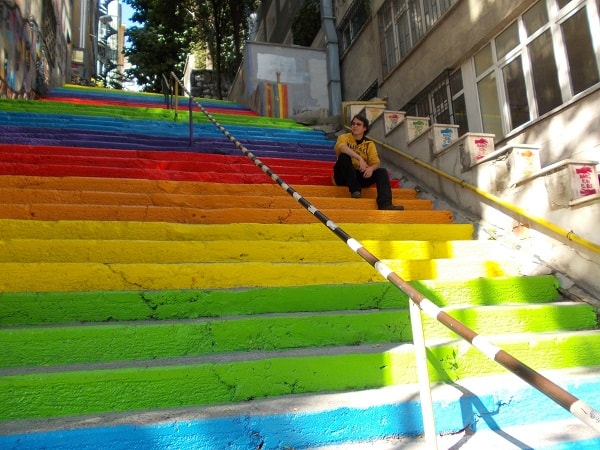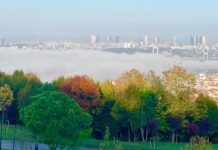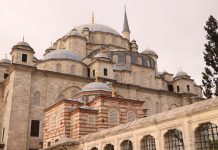
Protest in Turkey can take many forms. Sadly enough, few of them will leave a positive imprint on your memory: TOMAs and tear gas, the tragic deaths of young Turks, and so on. But whenever there’s civil unrest, there is also a young generation of artists emerging to process and thereby preserve the controversies of their time.
Today, I write about a certain phenomenon that was technically not started by someone who can be considered a youth – in fact, he’s a retiree. Moreover, even his urban artwork had originally nothing to do with youth protest, but nevertheless inspired numerous follow-up artists and, by now, acquired global fame.
Originally, in late August 2013, Beyoğlu local Hüseyin Çetinel figured his neighbourhood was too grey and coloured three steps of a lengthy nearby staircase. As pedestrians made positive remarks, he and a friend decided to go several hundred steps further and turn the stairs into a rainbow. Days later, probably since the two didn’t bother asking for permission for their voluntary effort, authorities had the stairs re-painted in dull grey. However, upon public protests in favour of the rainbow stairs, those same authorities restored the colours in a manner similar to Çetinel’s design. And voila, one of Istanbul’s newest tourist attractions was created.
Since then, the rainbow motif has made its way into many formerly bland neighbourhoods, sometimes taking different shapes, such as the colourful spheres on each side of Bahariye Cad. in Kadıköy.
Even the foreign press featured this new tourist attraction. However, just as the rainbow spread geographically, it also spread semantically. In the wake of Gezi, both media and young follow-up artists interpreted the project of painting rainbows as a call for diversity, artistry, and liberal ideas. More specifically, some saw it as support for LGBT acceptance, with the rainbow being the symbol of the associated movement.
A work of art being perceived so very differently from the artist’s original intention is, in fact, a real life application of the ongoing debate in literature about the so-called “death of the author”. The idea is that it’s irrelevant who wrote a literary text and what that person intended the work to imply since every text is perceived subjectively by the reader. What matters is the ever-changing effect of the work on the individual reader.
This applies to all forms of self-expression. In theory, the deeper meaning of anything from Renaissance mural art to a dirty limerick inside a toilet stall is not dependent on the creator, but on what you as the recipient makes out of it.
An example: Samuel Beckett’s drama Waiting for Godot, in which the protagonists struggle and fail to find a meaning to life, is generally regarded as a prime example of absurdist theatre. It’s not the plot that’s important, it’s the study of human behaviour. The two main characters of Waiting for Godot have no traits, are at no specific place or time, and wait for someone who’s not an actual person. Only recently have new interpretations appeared. In one reading, the protagonists are refugees — one French-Jewish, one foreign — escaping France during the Nazi occupation with the help of a smuggler who fails them.
On a meta-level, I personally realised that a desperate man escaping the Holocaust and an absurd character who seems to have neither a past nor a future could easily confused by audiences; each interpretation is plausible. In fact, this different perspective on the play sparked in me a whole series of thoughts on the subject, such as how Nazi propaganda and the persecution of Jews could have resulted in a loss of identity and confusion among the Jewish community, which in turn encouraged me to think and reflect even more.
Of course, the author isn’t always “dead”. Knowing about the biographical and literary background of a writer can help you read between the lines. You might not find any sense in Kafka unless you know about his struggle with patriarchy and the stiff autocratic system of his time. Understanding his emotional situation while writing his stories might help you to comprehend his art and thus reflect on your own life. For instance, reading about Kafka’s nightmarish world in which bureaucracy is an end in itself and rules are as strict as they are meaningless could lead you to take a new perspective on bureaucracy in Turkey, for better or worse. This is how art changes us, turning psychically disturbed cave-dwellers into thoughtful spirits observing the world open-eyed and open-minded.
You hopefully see how this excursion into the field of literature is relevant to the colourful stairs in Turkey. No matter the original intention, a generation of young street artists has found a way to express themselves. Tolerance, peace, protest, civil unrest, improvement of living conditions – people are promoting their ideas without stepping on anyone’s feet. On the contrary, their art is made for people to tread on.
A colourful mind doesn’t grow in a colourless environment. Just as the rainbows popping up all over Turkish metropolitan areas allow you to appreciate the diversity surrounding us, they also — like other forms of art — provoke and challenge you to think, to consider. The rainbow shows its colors in pride, and full of defiance. Beautiful, rich, and open for interpretation.
Lukas Knopp is a blogger (livefromfaraway.wordpress.com
Featured Image Source: L. Knopp











This is lovely!
I concur with Liam.
Kudos on a great piece, Lukas!